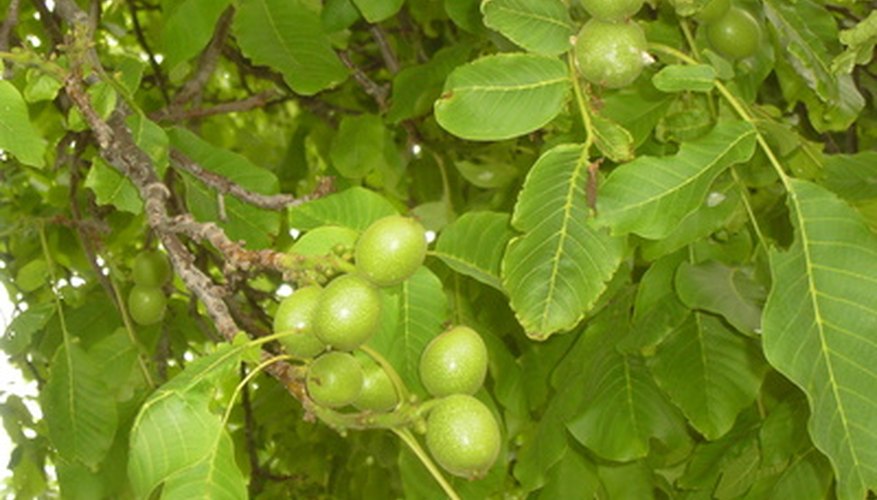English walnut trees (Juglans regia) produce a substance called juglone that inhibits the growth of many, but not all, other species of plants in nearby proximity. English walnut trees emit juglone in much lower quantities than black walnuts, but English walnuts are often grafted onto black walnut stock and thus may produce the same amount of this plant toxin. Select successful companion plants for your English walnut trees from among the known juglone-tolerant species.
Trees
Several species of trees can grow companionably with English walnut, but be sure to give each plenty of room to develop a sound root structure. Eastern redbud (Cercis canadensis) and Canadian hemlock (Tsuga canadensis) will grow under or near even the high-juglone producing black walnut, according to the Ohio State University Extension. These two native North American trees will also provide excellent bird habitat. Several varieties of maples, birches and holly will also grow near walnut trees, according to Tom Rood of the Cornell Cooperative Extension of Yates County. These will all add to a woodland habitat effect when planted near walnut. Many fruit trees are also juglone-tolerant. Peach, nectarine, cherry and plum will all grow as companions to English walnut and add to the production value of a homestead property.
- Several species of trees can grow companionably with English walnut, but be sure to give each plenty of room to develop a sound root structure.
- Peach, nectarine, cherry and plum will all grow as companions to English walnut and add to the production value of a homestead property.
Vines and Shrubs
Several species of ornamental or edible vines and shrubs will complement a walnut tree planting. Clematis, rose of Sharon, and forsythia will all bloom beneath an English walnut tree, according to the Ohio State University Extension. Hydrangeas and lilacs also make good plantings near walnut, advises the Cornell Cooperative Extension of Yates County, as do rhododendrons and arbor vitae. Multiflora roses will grow near walnuts, as will black raspberries, which conveniently yield the key ingredients for a host of black raspberry-walnut baked goods and confections.
- Several species of ornamental or edible vines and shrubs will complement a walnut tree planting.
- Hydrangeas and lilacs also make good plantings near walnut, advises the Cornell Cooperative Extension of Yates County, as do rhododendrons and arbor vitae.
Perennials and Groundcovers
Daylilies, phlox, irises and Virginia creeper all thrive below English walnut trees, advises the New Mexico State University Cooperative Extension. Bulbs like muscari, crocus, Spanish bluebell, daffodils and tulips are also good choices for spring colour beneath the walnut trees. Wildflowers like Dutchman's breeches and Jack in the pulpit will also grow near walnuts and create a charming woodland atmosphere. Hostas and many ferns will also form a thick groundcover beneath walnuts.
- Daylilies, phlox, irises and Virginia creeper all thrive below English walnut trees, advises the New Mexico State University Cooperative Extension.
- Bulbs like muscari, crocus, Spanish bluebell, daffodils and tulips are also good choices for spring colour beneath the walnut trees.
Annuals and Vegetables
For annual colour beneath English walnut trees, try calendula, begonias, morning glory, pansies or zinnias, suggests the Ohio State University Extension. Squash, melons, beans and corn will also work companionably with walnut, advises the Cornell Cooperative Extension of Yates County. Carrots are suggested as compatible with walnut, but may have difficulty growing amongst the dense tree roots. Raised bed plantings or pots under walnut trees can also add colour while minimising plant's exposure to the juglone-producing roots.
- For annual colour beneath English walnut trees, try calendula, begonias, morning glory, pansies or zinnias, suggests the Ohio State University Extension.
- Squash, melons, beans and corn will also work companionably with walnut, advises the Cornell Cooperative Extension of Yates County.
